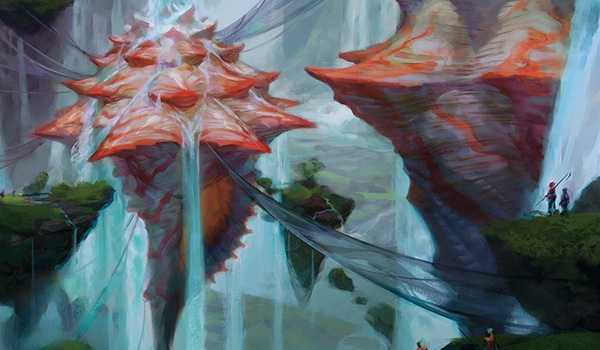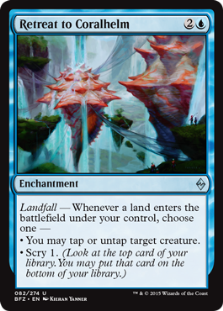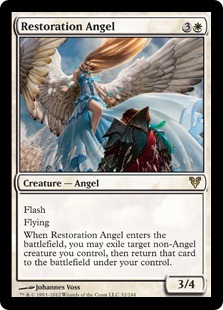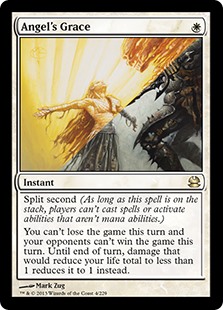Are you a Quiet Speculation member?
If not, now is a perfect time to join up! Our powerful tools, breaking-news analysis, and exclusive Discord channel will make sure you stay up to date and ahead of the curve.
This week in Magic, everything is freakin’ awesome. Seriously, I have not been this excited about a Modern metagame since before Splinter Twin was a deck (so, like the format’s conception). Recently, Modern has experienced a roller-coaster of shifts, with Amulet Bloom/Splinter Twin’s bannings and Eldrazi’s swift rise and fall. Today, we’ll look over the results of last weekend’s Grand Prix in Charlotte, analyze some decklists, and talk about exactly why Modern is so awesome right now.

[wp_ad_camp_1]
The Top 8
- Ad Nauseum
- Naya Company
- Jund (2)
- Kiki Chord
- Bant Knightfall Company
- Scapeshift
- Suicide Zoo
With seven different archetypes in the Top 8, GP Charlotte starts off strong with an A+ on the diversity front. Once again, the old-guard format mainstays such as Affinity and Burn are nowhere to be found. While these archetypes have too strong of a pedigree to disappear entirely, for the moment it appears that they have successfully been pushed out of the picture. In their place, various fast combo archetypes and aggressive strategies have risen to combat the increase in control and midrange reactive strategies. Balance in Modern rests on shaky ground; the reactive control and midrange strategies fight to contain the blisteringly fast combo decks and more tricky aggressive archetypes.
As always, when analyzing Top 8s it is prudent to look at the information multiple ways, both by unique archetype and by general classification. Sorted into macro-archetypes, GP Charlotte’s Top 8 looks like this:
- Value Midrange - 3
- Fast Combo - 2
- Midrange - 2
- Combo-Control - 1
While Ad Nauseum won the event, overall the top-performing macro-archetype was clearly Value Midrange. Naya Company, Bant Knightfall and Kiki Chord each worked to blur the line between “aggressive” and “midrange,” incorporating combo elements and value-generating effects to present alternate angles of attack. We’ll get to the champion’s list later on, but this week I’d like to break tradition by starting with these lists instead.
"Naya Company, by Jon Bolding (2nd, GP Charlotte)"
A green-white creature deck splashing Lightning Bolt at its core, Naya Company is traditionally built with a few straightforward goals in mind. Common Naya Company lines aim to take advantage of mana creatures to accelerate out high-impact, undercosted three-drops on Turn 2 and Collected Company to refuel on Turn 3.  Collected Company serves multiple functions in this archetype, and can offer the deck a lot of strength and flexibility in every matchup. Rather than focusing on assembling combo pieces, Naya Company is just focused on generating value, with the best reveals being three-drops and Tarmogoyf. Collected Company can help dig for sideboard bullets like Kataki, War's Wage and Kor Firewalker, and can provide an alternate angle of attack against control decks (casting at end of turn, then untapping into a Blood Moon or other threat).
Collected Company serves multiple functions in this archetype, and can offer the deck a lot of strength and flexibility in every matchup. Rather than focusing on assembling combo pieces, Naya Company is just focused on generating value, with the best reveals being three-drops and Tarmogoyf. Collected Company can help dig for sideboard bullets like Kataki, War's Wage and Kor Firewalker, and can provide an alternate angle of attack against control decks (casting at end of turn, then untapping into a Blood Moon or other threat).
Most Naya Company lists stay fairly close to the “stock” options, varying between high-impact sideboard options depending on the metagame. Collected Company pressures the archetype to maximize creatures, leaving most lists to play a mixture of 22-23 lands, 12 spells (Collected Company, Lightning Bolt, Path to Exile) and around 25-26 creatures (9-11 of which are mana creatures). Archetype staples like Tarmogoyf, Knight of the Reliquary, and Loxodon Smiter leave only a few maindeck slots for customization. While some lists opt for Voice of Resurgence or Wall of Roots, Jon instead chose to play 3 Scavenging Ooze, 2 Qasali Pridemage and a singleton Tireless Tracker.
Tireless Tracker might seem unassuming at first, but imagine a Turn 3 scenario where we are untapping with a mana creature in play. Resolving Tireless Tracker lets us play a fetchland, granting an immediate Clue trigger to gain us a card later when we have extra mana to spend. ![]() Even if they attempt to remove the Tracker immediately, we can still crack the fetchland and get another Clue trigger, building our own Divination basically for free. The longer Tireless Tracker remains on the battlefield, the more value he generates for us, and as a result he can become a big lightning rod to clear the way for our Tarmogoyf and Knight of the Reliquary to stick around.
Even if they attempt to remove the Tracker immediately, we can still crack the fetchland and get another Clue trigger, building our own Divination basically for free. The longer Tireless Tracker remains on the battlefield, the more value he generates for us, and as a result he can become a big lightning rod to clear the way for our Tarmogoyf and Knight of the Reliquary to stick around.
Tireless Tracker is a solid addition, but Jon’s finals performance is due more to archetype choice than specific list modifications. Naya Company enjoys strong matchups against graveyard strategies with its three maindeck Scavenging Ooze, and Collected Company ensures Naya will be able to promptly find Spellskite, Kor Firewalker, and Kataki, War's Wage in post-board games. Naya Company has traditionally struggled against midrange and control strategies that are able to effectively combat its card advantage effects, but Jon’s list looks like it has found a way to improve those matchups as well.
Bant Knightfall, by Eli Kassis (8th, GP Charlotte)
Knightfall is an archetype that has popped up here and there occasionally for the past few months, but has never put up any significant results. Eli Kassis finally broke through with a Top 8 performance with this list. Knightfall decks have landed all over the spectrum, from tempo-oriented lists with Remand and Steppe Lynx, to Geist of Saint Traft-focused strategies with Snapcaster Mage, and everything else in between.
 Eli kept things relatively simple, opting for a base green-white Collected Company deck with the Retreat Combo “thrown in” to keep opponents honest. Sound familiar? Like Jon, Eli was clearly convinced that a base green-white aggressive deck with additional flexible elements was the best place to be this weekend, and his gamble paid off. Collected Company again shines through as an all-star---both against reactive strategies as a source of card advantage, and against combo strategies as a source of disruption.
Eli kept things relatively simple, opting for a base green-white Collected Company deck with the Retreat Combo “thrown in” to keep opponents honest. Sound familiar? Like Jon, Eli was clearly convinced that a base green-white aggressive deck with additional flexible elements was the best place to be this weekend, and his gamble paid off. Collected Company again shines through as an all-star---both against reactive strategies as a source of card advantage, and against combo strategies as a source of disruption.
Looking past the Retreat to Coralhelm combo aspect of the archetype, Eli takes much greater advantage of the blue splash in his archetype than the red splash in the Naya Company list. While he has less removal to deal with opposing creatures, access to blue gives him counterspells in the sideboard to fight other midrange and control strategies, while giving him a ton of play against combo. As a result, we see the inclusion of defensive-oriented creatures like Courser of Kruphix, Spellskite, Kitchen Finks, and Voice of Resurgence over aggressive options like Qasali Pridemage or Loxodon Smiter. While I still think room should be made for a playset of Tarmogoyf (he is the gold standard of Modern, by the way) overall I think Eli’s list is really tight and focused on his primary objective while giving him flexibility and play in matchups across the format.
Kiki Chord, by Robert Graves (3rd, GP Charlotte)
A much “bigger” Naya Company deck (albeit without Collected Company itself), Kiki Chord seeks to present a similar aggressive strategy alongside an alternate angle of attack in the form of its own infinite combo potential.  This archetype has seen middling success in the past few months. While it's definitely not as popular as Naya Company, it is proven in a way that Bant Knightfall has yet to accomplish.
This archetype has seen middling success in the past few months. While it's definitely not as popular as Naya Company, it is proven in a way that Bant Knightfall has yet to accomplish.
Here, Nahiri, the Harbinger makes a gratuitous appearance, proving with her inclusion that she’s powerful enough to exist in Modern on rate alone---this list contains no Emrakul, the Aeons Torn to “instant-win” with the ultimate. However, her ultimate can still find one half of the infinite Kiki Jiki-Restoration Angel combo, which should often be enough to win with any sort of existing board state. Even her normal +2 works to help discard extra mana creatures or dead spells, and dig further for combo elements or action in general.
Ad Nauseam, by Andreas Ganz (1st, GP Charlotte)
Ad Nauseam taking home the trophy completely blows me away. I won’t go into the details of how the combo operates (as it should be pretty straightforward) and instead focus on the game flow.
 Without a Lotus Bloom, the archetype must reach six mana before it can combo with Angel's Grace, which means Turn 4 at the earliest with a Pentad Prism in play. With Phyrexian Unlife on the battlefield, Ad Nauseam can simply just cast its namesake card once it hits the requisite five mana, but this is still Turn 3 at the earliest (and assuming a really good draw).
Without a Lotus Bloom, the archetype must reach six mana before it can combo with Angel's Grace, which means Turn 4 at the earliest with a Pentad Prism in play. With Phyrexian Unlife on the battlefield, Ad Nauseam can simply just cast its namesake card once it hits the requisite five mana, but this is still Turn 3 at the earliest (and assuming a really good draw).
Now, I know Simian Spirit Guide can often speed up the clock a bit, but this is still a relatively slow combo compared to something like Living End, Infect, or Tron. And Ad Nauseam can’t afford to devote many (if any) slots to removal or board control.
Clearly, all the midrange and semi-aggressive decks have pushed the low end out of the metagame, culturing an environment where a middle-of-the-road archetype like Ad Nauseam can thrive. In my experience, Ad Nauseam is built to beat up on the midrange Company decks, yet struggles against aggressive strategies, control strategies, and strategies with disruption alike.  Yes, Boseiju, Who Shelters All and Pact of Negation are solid against control, but Dispel and Inquisition of Kozilek alongside a quick Tasigur, the Golden Fang to apply pressure will still give you fits.
Yes, Boseiju, Who Shelters All and Pact of Negation are solid against control, but Dispel and Inquisition of Kozilek alongside a quick Tasigur, the Golden Fang to apply pressure will still give you fits.
Nevertheless, Andreas took home the trophy on the back of some exceptional play (Ad Nauseam requires really tight play to take deep into an event). These tricky aggro-midrange lists might be riding the line aggressive decks have to take to compete in this metagame, but if they continue to show up in strong numbers I expect Ad Nauseam to be well positioned to take advantage.
Conclusion
While Ad Nauseam fought through a favorable Top 8 to take home the trophy, the clear winners on the weekend (in my mind) were the various flavors of aggro-midrange designed to spread the true midrange and control lists thin. What do you think? Was Ad Nauseam’s result a flash in the pan? Do you expect it to put up strong results moving forward? Let me know in the comments, and I’ll see you next week!





… But I mean are we would really be happy to see modern become goodstuff midrange strategies like those ones all around? Because sometimes I feel like it is everywhere at the top tables right now. Top 8 in this article is practically 5 creature value decks, two aggressive creature decks and one obscure combo (diamond in this sea of silly bears).
Why yes, I *would* be happy to see Modern become mostly about fair, interactive games where both players are involved in reciprocal decision-making. Thanks for asking.
I’ve been in the format for just under a year now, and it’s only just starting to look like it’s okay to actually try to play Magic with the other person at the table instead of just trying to ignore each other and hope your deck goes off faster than the other guy’s. Maybe I’m the outlier, but I see this as a good thing. I want competition, not recitation.
We see fair strategies all around in standard and I personally want to play modern not just for stronger cards but for different means to win. Being fair is boring.
Games in which both players have decision trees beyond “did I bring and then DRAW sideboard hoser _____” or “my goldfish is faster than yours” are not boring. Wanting to win is justifiable cause for playing mindless linear decks, wanting to have fun is not.
I’m not very impressed with these sentences: “The old-guard format mainstays such as Affinity and Burn are nowhere to be found. While these archetypes have too strong of a pedigree to disappear entirely, for the moment it appears that they have successfully been pushed out of the picture.”
Why? Because simultaneous to GP Charlotte, the even larger GP Los Angeles was taking place and old-guard format mainstays like Affinity (and Merfolk) were all over it. In fact, the final match featured a 13 year-old (!) piloting Affinity (but losing in the most unlikely fashion to the fish).
As per the previous article on these GPs at Modern Nexus, Affinity was one of the two best performing archetypes over the weekend and was ANYTHING but “pushed out of the picture.” In contrast, it was one of the better Grand Prix weekends Affinity (or any archetype) has had.
I have to agree with this – in the context of Sheridan’s article (which admittedly pooled data from LA and Charlotte, but still), these sentences made no sense. And in the case of an event as large as a GP, looking at just the Top 8 and making sweeping declarations about the metagame comes off as myopic – expand your sights to the Top 32 in Charlotte, and the Burn and Affinity pop right back up. They weren’t out in the same numbers as they were in LA, but they were around. And speaking of “old-guard format staples”… Isn’t that Jund by definition? It’s eaten 2 bannings and it’s still around. If that’s not a format staple, I don’t know what is.
Now granted, I still agree with a lot of what this article is saying: the metagame is trending to a fairer, more interaction-oriented place overall (mostly because it was awful hard for it to get LESS interactive, but that’s neither here nor there), current combo decks are either fast and resilient or have a value-based backup plan, and Collected Company proved that it’s still a metagame force to be reckoned with. I also appreciated the spotlight for decks like Knightfall (whose fringe status still mystifies me), Naya Company (which has come roaring back after being left for dead during Eldrazi Winter), and Kiki Chord (which is the latest deck to get on Team Nahiri). So I hope this post isn’t interpreted as unilateral negativity. I just think the point regarding linear aggro getting pushed out is a bit hyperbolic.
The problem is that no other author matches Sheridan for quality of post.
Sheridan sticks to the facts, is generally unemotional about his comments and then is willing to acknowledge his mistakes and then tries to see why he made such errors and if there’s anything to be learnt from them.
He also has the type of article series that allows him to keep writing weekly.
Jordan’s original article was actually what many wanted (an overview of RUG Delver after it won that SCG event), but it’s difficult to follow on that type of article – so we got a bunch of Jordan’s articles about ‘Monkey Grow’ which didn’t really sate any appetites (we already got the primer we wanted). He then followed that with a bunch of primers on decks no-one really cared for.
Trevor has a similar problem – the original articles on Grixis Control were great, but an author can’t sustain themselves on just writing on a single deck. Especially when they’re emotionally invested in the deck. Trevor has started branching into meta-analysis (see this article), but it makes no sense after Sheridan’s article in the same week (which is infinitely better).
Monday’s article by Ryan M Overturf was pretty much what everyone wanted (again). But I’d be interested to see how he could keep up the momentum by writing about the deck each and every week. It’s difficult, but you can see someone like Jeff Hoogland do it (with Kiki-Chord) – so it’s possible.
Modern Nexus might be best served trying to get a weekly deck tech on a break-out deck (ala RUG Delver, Grixis Control and now Grixis Delver) without requiring those authors to continuously provide content. And then figure out some sort of weekly schedule that isn’t just thoughts on a specific deck.
As it stands, I read everything Sheridan writes word for word – and then gloss over the rest. I can’t imagine I’m in the minority.
Content aside, the Ad Nauseam decklist in this article is incorrect. Ganz played only 2 Temple of Enlightenment, making for a total of 60 mainboard cards.